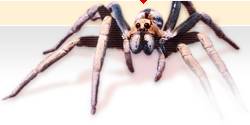
Mites
Order Mesostigmata
(by Bruce Halliday)
The order Mesostigmata includes about 80 families of relatively large mites with adult body lengths in the range 300-3000 µm. They are characterised by a series of leathery sclerotised plates that cover the body, and by a pair of laterally-placed stigmata, which are the external openings of the tracheal system. Most are predatory, while a few also feed on pollen and nectar. They occur in a wide range of habitats, including soil and litter, but are also abundant in dung, carrion, compost, and in the nests of vertebrates. Many are beneficial, contributing to the control of insect and mite pests. Notable among these is the arboreal family Phytoseiidae, which are widely used in the control of spider mites that damage crop plants (Gerson et al. 2003). Many families are parasites of vertebrates, including families such as the Dermanyssidae and Macronyssidae, which parasitise domesticated animals and can attack humans (Southcott 1976). Many families have associations with insects. These relationships vary from simple phoresy for the purpose of dispersal, to much closer relationships in which the mite has specialised morphological and behavioural adaptations at different stages of the life cycle that are involved in its interaction with its insect carrier. Sexual dimorphism is common, in the general arrangement of body sclerites, in modification of the legs of the male which are used in fighting, and in structures on the male chelicerae that are used in sperm transfer.
References
Gerson U., Smiley R.L. & Ochoa R. 2003. Mites (Acari) for Pest Control. Blackwell, Oxford, 539 pp.
Southcott R.V. 1976. Arachnidism and allied syndromes in the Australian region. Records of the Adelaide Children`s Hospital 1, 97-186.

